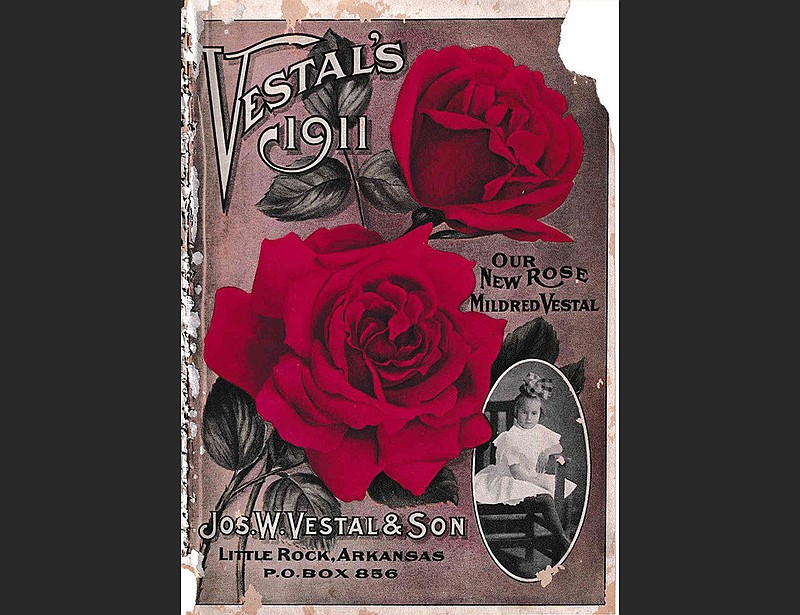Maybe, while walking along the river trail in North Little Rock, you have seen in the Baring Cross neighborhood a large smokestack with the word "Vestal" painted on it. This is all that remains of the Vestal Nursery, which operated for more than 100 years, cultivating and shipping flowers across the United States. By the mid-20th century, it had one of the largest greenhouse spaces in the United States.
Joseph Wysong Vestal, a Quaker horticulturist in Cambridge City, Ind., grew and sold plants as early as 1855, following prior Vestal family advancements in horticultural technology. By 1860, J.W. Vestal was cultivating greenhouse flowers. In 1861, Vestal began publishing an annual floral and vegetable catalog first titled "Roses, New Plants, and Special Merit Plants," establishing Vestal as one of the first U.S. mail-order operations in existence. The catalog was published for 93 consecutive years.
Seeking a warmer climate and a more favorable shipping radius, J.W. Vestal moved in 1880 to the north bank of the Arkansas River, adjacent to the 1873 Baring Cross railway bridge, in what was then part of Little Rock. The location choice was influenced by the availability of low-cost riverine agricultural land from the Iron Mountain Railroad. By 1880, plants were being shipped to all states east of the Rocky Mountains, especially to Chicago and St. Louis. J.W. Vestal added his youngest son, Charles Howell Vestal, to the business name in 1890.
With the notation of "Re-Established at Little Rock, 1881," J.W. Vestal & Son continued publication of the annual catalog of "Select, New, Rare, and Beautiful Plants; Roses." The 1906 catalog listed more than 170 distinctive varieties of strawberries, in a wide assortment of shapes, sizes, and colors, including purple and orange. In 1914, J.W. Vestal & Son mailed a total of 50,000, 80-page catalogs to worldwide customers. The Great Mississippi Flood of 1927 reached its peak on April 20, 1927, inundating the Vestal riverine lands. However, the greenhouses contained plant benches several feet above the peak flood level, and the rose nursery was on high ground, saving the majority of the crops from devastation.
The J.W. Vestal & Son company was known for roses and magnolias. The most popular Vestal rose was the thornless David O. Dodd, developed in 1926 and honoring a local Confederate hero. The David O. Dodd was advertised as "a magnificent rich crimson, flushed scarlet with well-shaped buds, carried erect and opening into a large, beautifully shaped flower." The rose became the official flower of the 1936 Arkansas Centennial Celebration, and Little Rock became known as the "City of Roses." Former Purdue University horticulture professor George Vestal, oldest son of Joseph, worked in the nursery business developing magnolia and evergreen trees until his untimely death in 1898. His magnolia trees survive in the 21st century along both River Road in North Little Rock and in front of his former homeplace on Roosevelt Avenue in Little Rock.
Following the 1928 death of Charles Vestal, the business changed from primarily supplying mail-order retail customers to supporting the regional wholesale market of florists, nurseries and other retailers under the third-generation leadership of Charles Howell Vestal and his brother, Joseph Walter Vestal.
By 1957, J.W. Vestal & Son operations grossed over $1 million in annual revenue with about 80 employees in one of the largest U.S. greenhouse ranges. The greenhouses totaled more than 300,000 square feet under glass and were heated by steam from three large coal-burning boilers, later converted to natural gas. Hundreds of acres of nursery fields were also in production. During the 1950s, J.W. Vestal & Son produced more than 1.2 million cut chrysanthemums and 750,000 cut roses on a year-round basis.
The annual catalogs ceased publication with the fall 1954 issue, following the death of Charles Vestal. From 1954 until 1967, Joseph Vestal oversaw operations. In 1967, third- and fourth-generation family members Ruth Vestal and Kent Vestal merged two-thirds of the existing business assets into a new corporation, Kent Vestal Company Inc., and continued in retail and wholesale florist endeavors until 1977, when the business was sold to publicly held Florafax International of Tulsa. The remaining one-third business interest was held by Joseph Vestal's family, who operated greenhouses until filing bankruptcy in the mid-1980s. All that remains of Vestal Nursery in the 21st century is the 90-foot brick smokestack built in the early 1930s.
— Sarah A. Vestal
This story is adapted by Guy Lancaster from the online Encyclopedia of Arkansas, a project of the Central Arkansas Library System. Visit the site at encyclopediaofarkansas.net.
